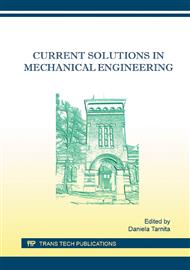p.453
p.459
p.467
p.473
p.479
p.485
p.489
p.495
p.501
Fuzzy Logic Treatment of the Laminated Composites Fracture
Abstract:
No one wants a material to fail. If it does happen then we have to know what the causes are and then what is the intensity at which it fails. To do this, we to do many experimental tests. The laboratory data for the laminated composites fractures normally exhibit scatter. This implies an element of uncertainty or vagueness in the results. Fuzzy logic is a natural means of expressing vague categories of information through fuzzy sets and offers means of performing logical operations. In this paper are considered some aspects regarding laminated composites fractures using fuzzy logic methods. The fuzzy logic treatment of the case considered in this work clearly show some risk of failures at lower parameter levels than might be expected using a deterministic treatment in which the vagueness of knowledge is masked and which might not be safeguard against by using a factor of safety value.
Info:
Periodical:
Pages:
479-484
Citation:
Online since:
January 2016
Authors:
Price:
Сopyright:
© 2016 Trans Tech Publications Ltd. All Rights Reserved
Share:
Citation:


